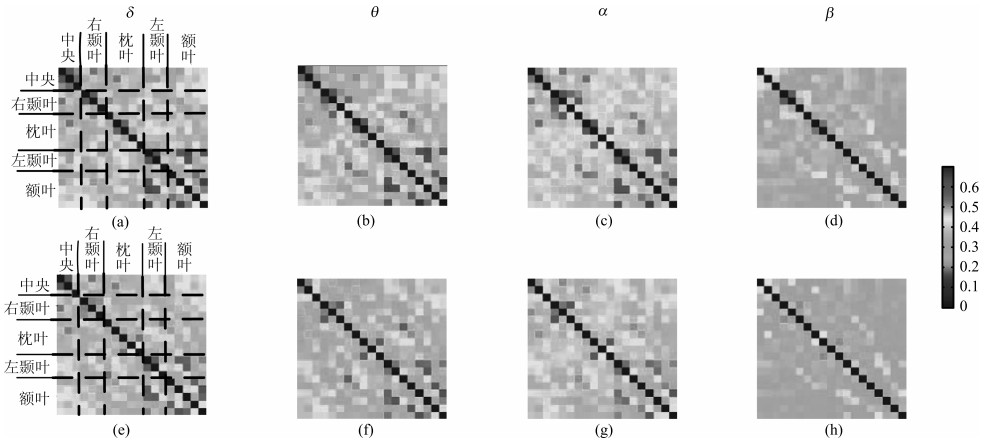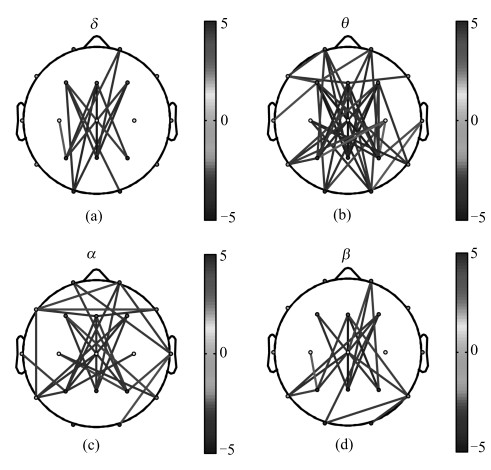|
[1]
|
郑毅. 孤独谱系障碍病因研究的现况. 科学通报, 2016, (7): 677- 681 https://www.cnki.com.cn/Article/CJFDTOTAL-KXTB201607003.htmZheng Yi. Current status of etiology of autism spectrum disorder. Science Bulletin, 2016, (7): 677-681 https://www.cnki.com.cn/Article/CJFDTOTAL-KXTB201607003.htm
|
|
[2]
|
Rubeis S D, He X, Goldberg A P, Poultney C S, Samocha K, Cicek A E, et al. Synaptic, transcriptional and chromatin genes disrupted in autism. Nature, 2014, 515: 209-215 doi: 10.1038/nature13772
|
|
[3]
|
Chiara H, Marita F, Richard P, Matthew A A, Torbjorn F. The cost of autism spectrum disorders. PLoS One, 2014, 9(9): e106552 doi: 10.1371/journal.pone.0106552
|
|
[4]
|
杨默涵, 陈万忠, 李明阳. 基于总体经验模态分解的多类特征的运动想象脑电识别方法研究. 自动化学报, 2017, 43(5): 743-752 doi: 10.16383/j.aas.2017.c160175Yang Mo-Han, Chen Wan-Zhong, Li Ming-Yang. Research on motor imaging EEG recognition based on multi-class features of total empirical mode decomposition. Acta Automatica Sinica, 2017, 43(5): 743-752 doi: 10.16383/j.aas.2017.c160175
|
|
[5]
|
樊越波, 彭晓玲, 黄丹. 脑电图在孤独症谱系障碍中的应用. 中国康复, 2017, 32(5): 379-382 https://www.cnki.com.cn/Article/CJFDTOTAL-ZLKF201705010.htmFan Yue-Bo, Peng Xiao-Ling, Huang Dan. Application of EEG in autism spectrum disorder. Chinese Journal of Rehabilitation, 2017, 32(5): 379-382 https://www.cnki.com.cn/Article/CJFDTOTAL-ZLKF201705010.htm
|
|
[6]
|
孙会文, 伏云发, 熊馨, 杨俊, 刘传伟, 余正涛. 基于HHT运动想象脑电模式识别研究. 自动化学报, 2015, 41(9): 1686-1692 doi: 10.16383/j.aas.2015.c150007Sun Hui-Wen, Fu Yun-Fa, Xiong Xin, Yang Jun, Liu Chuan-Wei, Yu Zheng-Tao. Identification of EEG induced by motor imagery based on Hilbert-Huang transform. Acta Automatica Sinica, 2015, 41(9): 1686-1692 doi: 10.16383/j.aas.2015.c150007
|
|
[7]
|
韩俊霞, 康健楠, 欧阳高翔, 佟祯, 丁萌, 张丹. 孤独症儿童脑电与眼动追踪研究. 科学通报, 2018, 63(15): 52-61 https://www.cnki.com.cn/Article/CJFDTOTAL-KXTB201815008.htmHan Jun-Xia, Kang Jian-Nan, Ouyang Gao-Xiang, Tong Zhen, Ding Meng, Zhang Dan. EEG and eye tracking in children with autism. Science Bulletin, 2018, 63(15): 52-61 https://www.cnki.com.cn/Article/CJFDTOTAL-KXTB201815008.htm
|
|
[8]
|
孙小棋, 李昕, 蔡二娟, 康健楠. 改进模糊熵算法及其在孤独症儿童脑电分析中的应用. 自动化学报, 2018, 44(9): 1672-1678 doi: 10.16383/j.aas.2018.c170334Sun Xiao-Qi, Li Xin, Cai Er-Juan, Kang Jian-Nan. Improved fuzzy entropy algorithm and its application in eeg analysis of children with autism. Acta Automatica Sinica, 2018, 44(9): 1672-1678 doi: 10.16383/j.aas.2018.c170334
|
|
[9]
|
Buzsaki G. Large-scale recording of neuronal ensembles. Nature Neuroscience, 2004, 7: 446-451 doi: 10.1038/nn1233
|
|
[10]
|
Cui D, Liu X Z, Wan Y, Li X L. Estimation of genuine and random synchronization in multivariate neural series. Neural Networks, 2010, 23(6): 698-704 doi: 10.1016/j.neunet.2010.04.003
|
|
[11]
|
Ouyang G X, Wang Y H, Yang Z X, Li X L. Global synchronization of multichannel EEG in patients with electrical status epilepticus in sleep. Clinical EEG and Neuroscience, 2014, 46(4): 357-363 http://smartsearch.nstl.gov.cn/paper_detail.html?id=e4b3d0b02577343a3d9e1caaec011a69
|
|
[12]
|
Bhat S, Acharya U R, Dadmehr N, Adeli H. Clinical neurophysiological and automated EEG-based diagnosis of the alzheimer's disease. European Neurology, 2015, 74(3-4): 202-210 doi: 10.1159/000441447
|
|
[13]
|
Hudspeth W, Barry E R, Coben R, Clarke R N. EEG power and coherence in autistic spectrum disorder. Clinical Neurophysiology, 2008, 119(5): 1002-1009 doi: 10.1016/j.clinph.2008.01.013
|
|
[14]
|
Bernier R, Dawson G, Webb S, Murias M. EEG mu rhythm and imitation impairments in individuals with autism spectrum disorder. Brain and Cognition, 2007, 64(3): 228-237 doi: 10.1016/j.bandc.2007.03.004
|
|
[15]
|
Murias M, Webb S J, Greenson J, Dawson G. Resting state cortical connectivity reflected in EEG coherence in individuals with autism. Biological Psychiatry, 2007, 62(3): 270- 273 doi: 10.1016/j.biopsych.2006.11.012
|
|
[16]
|
Duffy F H, Als H. A stable pattern of EEG spectral coherence distinguishes children with autism from neuro-typical controls——a large case control study[Online], available: https://doi.org/10.1186/1741-7015-10-64, March 12, 2019
|
|
[17]
|
Duffy F H, Shankardass A, McAnulty G B, Als H. The relationship of Asperger's syndrome to autism: A preliminary EEG coherence study[Online], available: https://link.sprin-ger.com/article/10.1186/1741-7015-11-175, March 12, 2019
|
|
[18]
|
Courchesne E, Karns C M, Davis H R, Ziccardi R, Carper R A, Tigue Z, et al. Unusual brain growth patterns in early life in patients with autistic disorder: An MRI study. Neurology, 2001, 57(2): 245-254 doi: 10.1212/WNL.57.2.245
|
|
[19]
|
Hazlett H C, Poe M, Gerig G, Smith R G, Provenzale J, Ross A, et al. Magnetic resonance imaging and head circumference study of brain size in autism: Birth through age 2 years. Archives of General Psychiatry, 2005, 62(12): 1366 -1376 doi: 10.1001/archpsyc.62.12.1366
|
|
[20]
|
Lainhart J E, Bigler E D, Bocian M, Coon H, Dinh E, Dawson G, et al. Head circumference and height in autism: A study by the collaborative program of excellence in autism. American Journal of Medical Genetics, 2006, 140A(21): 2257-2274 doi: 10.1002/ajmg.a.31465
|
|
[21]
|
Barttfeld P, Wicker B, Cukier S, Navarta S, Lew S, Sigman M. A big-world network in ASD: Dynamical connectivity analysis reflects a deficit in long-range connections and an excess of short-range connections. Neuropsychologia, 2011, 49(2): 254-263 doi: 10.1016/j.neuropsychologia.2010.11.024
|
|
[22]
|
Smit D J A, Stam C J, Posthuma D, Boomsma D I, de Geus E J C. Heritability of "small-world" networks in the brain: A graph theoretical analysis of resting-state eeg functional connectivity. Human Brain Mapping, 2008, 29(12): 1368- 1378 doi: 10.1002/hbm.20468
|
|
[23]
|
Patidar S, Pachori R B, Upadhyay A, Acharya U R. An integrated alcoholic index using tunable-q wavelet transform based features extracted from EEG signals for diagnosis of alcoholism. Applied Soft Computing, 2016, 50: 71-78 doi: 10.1016/j.asoc.2016.11.002
|
|
[24]
|
Zeng K, Yan J Q, Wang Y H, Sik A, Ouyang G X, Li X L. Automatic detection of absence seizures with compressive sensing EEG. Neurocomputing, 2016, 171: 497-502 doi: 10.1016/j.neucom.2015.06.076
|
|
[25]
|
Orekhova E V, Elsabbagh M, Jones E J, Dawson G, Charman T, Johnson M H, et al. EEG hyper-connectivity in high-risk infants is associated with later autism[Online], available: https://link.springer.com/article/10.1186/1866-1955-6-40, March 12, 2019
|
|
[26]
|
ZBosl W, Tierney A, Tager F H, Nelson C. EEG complexity as a biomarker for autism spectrum disorder risk. BMC Medicine[Online], available: https://link.springer.com/article/10.1186/1741-7015-9-18, March 12, 2019
|
|
[27]
|
Durka P J, Klekowicz H, Blinowska K J, Szelenberger W, Niemcewicz S. A simple system for detection of EEG artifacts in polysomnographic recordings. IEEE Transactions on Biomedical Engineering, 2003, 50(4): 526-528 doi: 10.1109/TBME.2003.809476
|
|
[28]
|
刘志勇, 孙金玮, 卜宪庚. 单通道脑电信号眼电伪迹去除算法研究. 自动化学报, 2017, 43(10): 1726-1735 doi: 10.16383/j.aas.2017.c160191Liu Zhi-Yong, Sun Jin-Xi, Bu Xian-Geng. Study on the removal algorithm of ocular electro-optical artifacts for single-channel EEG signals. Acta Automatica Sinica, 2017, 43(10): 1726-1735 doi: 10.16383/j.aas.2017.c160191
|
|
[29]
|
Stuss D T, Knight R T. Principles of frontal lobe function. European Journal of Neurology, 2003, 10: 111-118 http://ci.nii.ac.jp/ncid/BB11843727?l=en
|





 下载:
下载:




